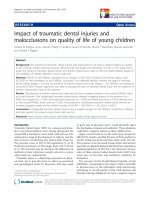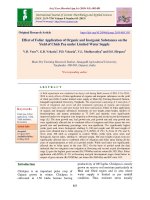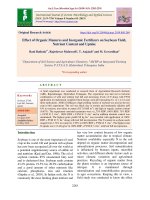Effect of organic manures and biofertilizers on quality of spinach beet (Beta vulgaris var. bengalensis)
Bạn đang xem bản rút gọn của tài liệu. Xem và tải ngay bản đầy đủ của tài liệu tại đây (236.53 KB, 6 trang )
Int.J.Curr.Microbiol.App.Sci (2018) 7(9): 1312-1317
International Journal of Current Microbiology and Applied Sciences
ISSN: 2319-7706 Volume 7 Number 09 (2018)
Journal homepage:
Original Research Article
/>
Effect of Organic Manures and Biofertilizers on Quality of Spinach
Beet (Beta vulgaris var. bengalensis)
Asma Jabeen*, Sumati Narayan, Khursheed Hussain,
Shakeel Ahmed Mir and Farooq Ahmed Khan
Division of Vegetable Science, Sher-e-Kashmir University of Agricultural Sciences and
Technology of Kashmir, Shalimar-190025, J&K, India
*Corresponding author
ABSTRACT
Keywords
Spinach beet,
Vermicompost,
Biofertilizers,
Quality
Article Info
Accepted:
10 August 2018
Available Online:
10 September 2018
A field experiment was conducted at Vegetable Experimental Field, SKUAST- K Shalimar
during Rabi season 2016-17 to evaluate the effect of organic manures and biofertilizers on
quality of spinach beet. The experiment was laid out in RCBD with nine treatment
combinations replicated three times. The treatments comprised of organic manures viz.,
farm yard manure, sheep manure, vermicompost, mustard cake and two types of biofertilizers namely Azospirillum and PSB including RFD (recommended fertilizer dose) as
control. Results revealed that quality parameters like dry matter content (15.92, 16.47 and
29.26), ascorbic acid content (202.52, 166.10 and 155.12 mg 100 g-1), crude fibre content
(9.50, 8.86 and 7.76 %) and leaf chlorophyll content (3.25, 0.98 and 0.76 mg g -1) were
highest with the treatment T6 (vermicompost @ 3 tonnes ha-1 + biofertilizers @ 5 kg ha-1).
Lowest nitrate content (447.33, 348.33 and 268.33 mg kg-1) in leaves were found with the
treatment T7 (FYM @ 12.0 t ha-1 + biofertilizers @ 5 kg ha-1) and was statistically at par
(453.00, 355.39 and 270.33 mg kg-1) with treatment T6 (vermicompost @ 3 tonnes ha-1 +
biofertilizers @ 5 kg ha-1). Highest leaf moisture content (91.97, 90.23 and 87.57 %) was
registered where mustard cake @ 1.2 t ha-1 was applied.The highest benefit cost ratio
(B:C) of spinach beet (3.84) was also obtained with the application of vermicompost @ 3
tonnes ha-1 + biofertilizers @ 5 kg ha-1.
Introduction
Spinach beet (Beta vulgaris var. bengalensis;
2n=2x=18), commonly known as „Indian
spinach‟ in English and „Palak‟ in Hindi,
originated from Indo-Chinese region (Nath,
1976) belongs to the genus Beta, specie
vulgaris and family Chenopodiaceae. Leaves
of this might have been first used in Bengal
and hence known as var. bengalensis. It is also
called as Beet leaf and Desi palak. It is closely
related to beet root, sugar beet, and Swiss
chard. Sea beet (Beta vulgaris var. maritima)
is the ancestor of palak. It is commonly grown
for its tender and soft succulent leaves.
Spinach beet leaves are valued much for their
medicinal properties. It is a good source of
natural antioxidants such as flavonoids,
polyphenols, vitamins and folic acid. Organic
manures like vermicompost contains water
soluble components such as humic acid,
1312
Int.J.Curr.Microbiol.App.Sci (2018) 7(9): 1312-1317
growth
regulators,
vitamins
and
micronutrients which increase the availability
of nutrients resulting in better quality produce.
Excessive use of inorganic fertilizers creates
environment related problems and situation
can be improved through the use of biofertilizer (Saadatnia and Riahi, 2009). Organic
manures have the potential to mitigate the soil
degradation and gave higher benefit cost ratio.
In view of the above facts the research was
conducted with the following objective:
T8=T4 +Biofertilizers (Azospirillum + PSB @
5.0 kg ha-1)
T9=T5 +Biofertilizers (Azospirillum + PSB @
5.0 kg ha-1)
The quality observations were recorded on
moisture content, dry matter content, crude
fibre content, leaf chlorophyll content, leaf
ascorbic acid content and leaf nitrate content.
To find out the BCR the following formula
was used:
To assess the effect of organic manures and
biofertilizers on quality of spinach beet and to
work out the economics.
Gross returns
Benefit cost ratio (B: C) = -----------------------Total cost of cultivation
Materials and Methods
Quality attributes were recorded at first,
second and third cuttings respectively. Data
was analyzed as per standard statistical
procedures (Gomez and Gomez, 1984).
The present study was carried out during Rabi
season of 2016-17 at Vegetable Experimental
Field of Division of Vegetable Science,
SKUAST-Kashmir, using one variety of
spinach beet “Pusa Jyoti” with a spacing of 30
cm apart in rows and later thinned to 10 cm
spacing between plants within a row
experimented in Randomized Complete Block
Design with three replications. The treatment
details are as below:
T1=Recommended dose of fertilizer (RDF) i.e.
N @ 60.0 kg ha-1
T2=Vermicompost @ 3.0 t ha-1
T3=Farmyard manure@ 12.0 t ha-1
T4=Sheep manure @ 10.0 t ha-1
T5=Mustard cake @1.2 t ha-1
T6=T2+Biofertilizers (Azospirillum + PSB @
5.0 kg ha-1)
T7=T3 +Biofertilizers (Azospirillum + PSB @
5.0 kg ha-1)
Results and Discussion
The findings of the present study as well as
relevant discussion are summarized under
following headings:
Leaf moisture content
Data presented in table 1 revealed that highest
moisture content (91.97, 90.23 and 87.57 %)
was recorded in treatment T5 (Mustard cake
@1.2 t ha-1) followed by (89.15, 88.57 and
86.73 %) treatment T3 (Farmyard manure@
12.0 t ha-1) whereas lowest moisture content
(84.08, 83.53 and 81.73 %) was recorded with
the treatment T6 ( t ha-1+
Biofertilizers @ 5.0 kg ha-1). The above result
is in conformity with Bharad et al., (2013).
Regarding cutting effect on leaf moisture,
maximum leaf moisture was recorded in first
cutting (C1), followed by second cutting (C2)
whereas minimum leaf moisture content was
recorded in third cutting (C3). The moisture
1313
Int.J.Curr.Microbiol.App.Sci (2018) 7(9): 1312-1317
content was maximum in C1 because moisture
content is directly related to leaf area as
cutting increases the leaf area and thus
moisture content decreases.
As regards to cutting, maximum crude fibre
content was recorded in C1 followed by C2 and
minimum was recorded in C3.
Leaf chlorophyll
Dry matter content
Table 1 depicts that the maximum value for
dry matter (15.92, 16.47 and 18.27 %) was
recorded in treatment T6 (
t ha-1 + Biofertilizers @ 5.0 kg ha-1) followed
by (14.25, 16.33 and 17.73 %) treatment T2
(Vermicompost @ 3.0 t ha-1). Minimum dry
matter (8.03, 9.77 and 12.43 %) was registered
in treatment T5 (Mustard cake @ 1.2 t ha-1).
The improvement in dry matter may be
because of better availability and uptake of
nitrogen which might have led to balanced
C/N ratio and increased activity of plant
metabolism. The above result is in conformity
with that of Mehta et al., (2012) and Joshi and
Pal (2010).
With increase in leaf area, dry matter also
increases and in response to cutting maximum
dry matter was recorded in C3 and minimum
was recorded in C1.
Crude fibre content
Table 1 showed that maximum fibre content
(9.50, 8.86 and 7.76 %) was observed in
treatment T6 ( t ha-1+
Biofertilizers @ 5.0 kg ha-1) which was
statistically at par(9.35, 8.68 and 7.45) and
(9.10, 8.56 and 7.36 %) with the treatments T8
(Sheep manure @ 10.0 t ha-1 + Biofertilizers
@ 5.0 kg ha-1) and T7 (Farmyard manure @
12.0 t ha-1 + Biofertilizers @ 5.0 kg ha-1).
Minimum fibre content (7.59, 6.55 and 6.25
%) was recorded in treatment T3 (Farmyard
manure @ 12.0 t ha-1) and was at par (7.97,
7.02 and 6.02 %) with treatment T5 (Mustard
cake @ 1.2 t ha-1). Maximum fibre content in
palak was reported with the application of
poultry manure (Dange et al., 2013).
Table 1 revealed that maximum leaf
chlorophyll content (3.25, 0.93 and 0.76 mg
g-1) in spinach beet was recorded with the
treatment T6 ( t ha-1+
Biofertilizers @ 5.0 kg ha-1) followed by
(2.96, 0.86 and 0.73 mg g-1) treatment T2
(Vermicompost @ 3.0 t ha-1) whereas
minimum leaf chlorophyll (1.08, 0.28 and 0.21
mg g-1) was recorded in the treatment T1
(RFD). Similar results of improvement in
chlorophyll content due to addition of organic
manures have also been found by Singh et al.,
(2014) and Narkhede et al., (2011). More
chlorophyll content in leaves might be due to
macro and micro nutrients supplied by
vermicompost and biofertilizers particularly
nitrogen which is an important constituent of
chlorophyll. As regards to cutting, maximum
chlorophyll content was registered in first
cutting (C1) followed by C2 whereas minimum
chlorophyll content was recorded in C3.The
above result is in conformity with that of
Gairola et al., (2009).
Ascorbic acid content:
The maximum ascorbic acid content(202.52,
166.10 and 155.12 mg 100 g-1) was recorded
in treatment T6 ( t ha-1+
Biofertilizers @ 5.0 kg ha-1) followed by
(197.06, 99.02 and 85.24 mg 100 g-1)
treatment T8 (Sheep manure @ 10.0 t ha-1 +
Biofertilizers @ 5.0 kg ha-1) whereas
minimum ascorbic acid (119.01, 63.25 and
53.77 mg 100 g-1) was registered in treatment
T5 (Mustard cake @ 1.2 t ha-1). Increase in
ascorbic acid in leaves with added
biofertilizers along with vermicompost might
be due to its efficacy to fix atmospheric
nitrogen and enhanced carbohydrate synthesis.
1314
Int.J.Curr.Microbiol.App.Sci (2018) 7(9): 1312-1317
Table.1 Effect of organic manures and biofertilizers on quality parameters of spinach beet
Treatments
Leaf moisture content (%)
Dry matter content (%)
Crude fibre content (%)
nd
rd
st
nd
rd
st
I cutting 2 cutting 3 cutting I cutting 2 cutting 3 cutting I cutting 2nd cutting
3rd cutting
87.96
86.17
84.17
12.04
13.83
15.83
8.41
7.53
7.29
85.75
83.67
82.27
14.25
16.33
17.73
8.67
7.61
7.34
89.15
88,57
86.73
10.85
11.43
13.27
7.59
6.55
6.25
87.97
86.37
85.63
12.03
13.63
14.37
8.51
7.52
6.41
91.97
90.23
87.57
8.03
9.77
12.43
7.97
7.02
6.02
84.08
83.53
81.73
15.92
16.47
18.27
9.50
8.86
7.76
87.03
85.60
84.47
12.97
14.40
15.53
9.10
8.56
7.36
86.16
85.30
83.57
13.84
14.70
16.43
9.35
8.68
7.45
87.40
85.99
84.99
12.60
14.01
15.01
8.00
7.21
6.58
0.96
1.05
1.49
0.07
0.35
0.30
0.65
0.75
0.67
st
T1
T2
T3
T4
T5
T6
T7
T8
T9
C.D(p ≤
0.05)
Treatments
T1
T2
T3
T4
T5
T6
T7
T8
T9
C.D(p ≤
0.05)
Leaf chlorophyll content
Ascorbic acid content (mg 100g-1)
(mg g-1)
Ist cutting 2nd cutting 3rd cutting Ist cutting 2nd cutting 3rd cutting
1.08
0.28
0.21
124.41
66.74
53.43
2.96
0.86
0.73
201.81
87.76
75.30
2.06
0.55
0.45
130.39
78.63
66.91
1.96
0.46
0.38
182.80
73.22
60.97
1.74
0.38
0.27
119.01
63.25
53.77
3.25
0.93
0.76
202.52
166.10
155.12
2.96
0.65
0.54
197.86
88.58
73.24
2.89
0.59
0.50
197.06
99.02
85.24
2.19
0.39
0.47
130.05
83.19
71.89
0.04
0.03
0.05
1.20
1.00
1.48
1315
Leaf nitrate content (mg kg-1)
Ist cutting
811.00
529.00
588.33
591.00
692.00
453.00
447.33
581.00
650.00
14.33
2nd cutting
672.33
380.33
447.66
552.66
608.33
355.39
348.33
506.33
580.33
12.26
3rd cutting
608.00
295.33
355.33
436.33
542.66
270.33
268.33
430.00
528.66
14.75
Int.J.Curr.Microbiol.App.Sci (2018) 7(9): 1312-1317
Higher ascorbic acid content was reported in
tomato (Meena et al., 2014) with the
application
of
vermicompost
and
biofertilizers.
The maximum ascorbic acid was recorded in
first cutting (C1), followed by second cutting
(C2) and minimum was recorded in third
cutting (C3). The nutritional quality of a crop
decreases because the content of nutrients
especially vitamin C decreases with increased
plant age as reported by Sorenson (1994) in
lettuce.
Leaf nitrate content
The data presented in Table 1 showed that
minimum leaf nitrate content (447.33, 348.33
and 268.33 mg kg-1) was recorded in
treatment T7 (Farmyard manure @ 12.0 t ha-1
+ Biofertilizers @ 5.0 kg ha-1) which was
statistically at par(453.00, 355.39 and 270.33
mg
kg-1)
with
treatment
T6
-1
( t ha + Biofertilizers @
5.0 kg ha-1). Maximum nitrate content
(811.00, 672.33 and 608.00 mg kg-1) was
registered in treatment T1 (RFD). Similar
findings were reported by Qureshi et al.,
(2014) and Mahmoud et al., (2009).
Regarding cutting effect on leaf nitrate, the
maximum leaf nitrate was recorded in C1
which was followed by C2 whereas, minimum
was recorded in C3. This might be due to
nitrate reductase enzyme activity which
increased with plant age and thus decreased
the nitrate content. These results are in
accordance with the findings of Ahmed et al.,
(2000) and Ruiz and Romero (2002).
Benefit cost ratio
Figure 1 revealed that the highest benefit cost
ratio (3.84) was observed in treatment T6
(Vermicompost @ 3.0 t ha-1 + Biofertilizers
@ 5.0 kg ha-1) followed by (3.53) treatment
T2 (Vermicompost @ 3.0 t ha-1). The lowest
benefit cost ratio (2.12) was obtained from
treatment T5 (Mustard cake @ 1.2 t ha-1).
Vermicompost along with biofertilizers (T6)
was focused as more profitable than any other
treatment giving highest benefit cost ratio
(3.84) which is due to higher leaf quality.
Unique succulence, tenderness, colour and
size carried higher market value than other
treatments. So, it is proved that positive effect
of vermicompost on quality of spinach beet
can easily compete with inorganic fertilizers
or other treatments as having higher benefit
cost ratio. Similar findings were reported by
Narolia et al., (2009) in pear millet and
Sandeep (2013) in carrot.
References
Ahmed, A.H.H., Khalil, M.K. and Farrag,
A.M. 2000. Nitrate accumulation,
growth, yield and chemical composition
of Rocket (Erucaversicaria subsp.
Sativa) plant as affected by NPK
fertilization, kinetin and salicylic acid,
In: Proceedings of ICEHM 2000, pp:
495-508. Cairo University, Egypt.
Bharad, S.G., Snehal, D., Satpute, P. and
Baviskar, M.N. 2013. Effect of organic
manures and number of cuttings on
growth, yield and quality of Indian
spinach. The Asian Journal of
Horticulture 10 (1): 60-64.
Dange, M.B., Bhosale, A.M. and Barkule,
S.R. 2011. Effect of organic and
inorganic fertilizers on growth, yield
and quality of palak (Beta vulgaris var.
bengalensis). International Journal of
Plant Sciences 6 (1): 91-94.
Gairola, S., Umar, S. and Suryapani, S. 2009.
Nitrate accumulation, growth and leaf
quality of spinach beet as affected by
NPK fertilization with special reference
to potassium. Indian Journal of Science
and Technology 2: 35-39.
Gomez, K.A. and A.A. Gomez 1984.
1316
Int.J.Curr.Microbiol.App.Sci (2018) 7(9): 1312-1317
Statistical procedures for agricultural
research (2 ed.). John wiley and sons,
New York, 680p.
Joshi, R. and Pal, V. 2010. Effect of
vermicompost on growth, yield and
quality of tomato (Lycopersicum
esculentum L). African Journal of Basic
and Applied Sciences2 (3-4): 117-123
Mahmoud, E., Abd EL- Kader, N., Robin, P.,
Akkal-Corfini, N. and Abd ELRahman, L. 2009. Effects of different
organic and inorganic fertilizers on
cucumber yield and some soil
properties.
World
Journal
of
Agricultural Sciences 5 (4): 408-414.
Meena, R.K., Kumar, S., Maji, S., Kumar, D.
and Kumar, M. 2014. Effect of organic
manures and biofertilizers on growth,
flowering, yield and quality of tomato
cv. Pusa Sheetal. International Journal
of Agricultural Sciences 10(1):329-332
Narkhede, S.D., Attarde, S.B. and Ingle, S.T.
2011. Study of an effect of chemical
fertilizer and vermicompost on growth
of Chilli pepper (Capsicum annum).
Journal of Applied Sciences in
Environmental Sanitation6: 327-372.
Nath, P. 1976. Origin and taxonomy.
Vegetable Crops 3 (3): 246.
Qureshi, F., Wani, J.A., Bashir, U., Malik,
M.A. and Mir, S.A. 2014. Response of
farm yard manure and inorganic
nitrogen on vegetative growth, yield and
quality of leafy vegetables. An
International Journal of Biology and
Life Sciences 2 (3): 786-791.
Ruiz, J.M. and Romero, L. 2002. Relationship
between potassium fertilization and
nitrate assimilation in leaves and fruits
of cucumber (Cucumis sativus) plants,
Annals of Applied Biology 140: 241245.
Saadatnia, H. and Riahi, H. 2009.
Cyanobacteria from paddy fields in Iran
as biofertilizer in rice plants. Plant Soil
and Environment 55 (5): 207-212.
Sandeep, G. 2013. Effect of organic manures
on growth, root yield and quality of
Carrot (Daucus carota L.), M Sc (Hort.)
Thesis submitted to Dr. Y.S.R.
Horticultural
University,
Venkataramannagudem,
WestGodavari.
Singh, C.K., John, S.A. and Jaisal, D. 2014.
Effect of organics on growth, yield and
biochemical parameters of chilli
(Capsicum annum L.). IOSR Journal of
Agriculture and Veterinary Science 7
(7): 27-32.
Sorensen, J.N., Johansen, A.S., and Poulsen,
N. 1994. Influence of growth conditions
on the value of crisphead lettuce. Plant
Foods for Human Nutrition 46: 1-11.
How to cite this article:
Asma Jabeen, Sumati Narayan, Khursheed Hussain, Shakeel Ahmed Mir and Farooq Ahmed
Khan. 2018. Effect of Organic Manures and Biofertilizers on Quality of Spinach Beet (Beta
vulgaris var. bengalensis). Int.J.Curr.Microbiol.App.Sci. 7(09): 1312-1317.
doi: />
1317









